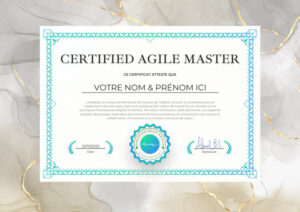Within the vibrant sphere of agile project management, the 4L retrospective emerges as a key tool for teams operating within the Scrum framework, offering a well-structured approach to reflect on and enhance work processes continuously.
This guide will walk you through the 4Ls retrospective’s core elements—Liked, Learned, Lacked, Longed For—outlining how to seamlessly conduct a session. You’ll receive practical tips for facilitating each part, ensuring your team can engage deeply with the process and derive meaningful insights for improvement.
Towards the article’s conclusion, you will find downloadable templates for Miro and Klaxoon, equipping you with the necessary tools to apply your newfound knowledge immediately.
Index
- 1 Detailed explanation of the 4Ls Retrospective
- 2 Step-by-Step Guide to the 4L Retrospective
- 3 Expert Advice and Tips for an Effective 4L Retrospective
- 4 Comparing with Other Retrospective Techniques
- 5 Free downloadable 4L Retrospective online templates
- 6 Conclusion and Importance of the 4Ls Retrospective
Detailed explanation of the 4Ls Retrospective
Detailed Explanation of the 4L Retrospective
In this section, we’ll go through each of the four “Ls” that make up the 4L retrospective. Let’s see how these elements fit perfectly into a Scrum team’s process of thinking and analyzing:
- Liked: This part is all about the positive things from the sprint or project. It encourages team members to talk about what they really liked. It’s a chance to focus on what went well and what everyone felt good about.
- Learned: Here, the team looks back on what they’ve learned. This is key for highlighting new skills or knowledge gained, helping the team grow stronger. It’s about understanding what experiences have taught us and how we can use them moving forward.
- Lacked: This section lets members identify what was missing, like resources, information, or support. It helps figure out what needs more attention or improvement for the next time, making sure the team knows where to make changes.
- Longed For: The last part lets team members share their hopes or what they wish for in future sprints, leading to clear goals and specific areas to improve. It’s about setting sights on what we want to achieve next and how to get there.
Each “L” is vital for getting a full picture of how the team works together and for creating a productive and positive agile workplace.
Step-by-Step Guide to the 4L Retrospective
Let’s dive into the steps to lead a productive 4L retrospective:
- Preparation: Clearly define the retrospective’s aim and ready all needed items, such as a whiteboard and sticky notes.
- Initial Discussion: Introduce the concept of the four “Ls” to the team, detailing the purpose behind each one.
- Individual Reflection: Allow team members some time to privately write down their thoughts for each “L.”
- Collective Sharing and Discussion: Create a supportive atmosphere for members to share their notes and explore the topics brought up.
- Action Plan Development: Work together to outline specific steps forward based on your collective insights.
- Conclusion and Follow-up: Wrap up by summarizing the agreed actions and arranging check-ins to monitor implementation.
By following these structured steps, your team will be well on its way to harnessing the full potential of the 4L retrospective for ongoing improvement and stronger collaboration.
Expert Advice and Tips for an Effective 4L Retrospective
This section will provide practical advice and expert tips to improve the efficiency of your 4L retrospective:
- Active facilitation: A skilled facilitator can guide the team through the retrospective, ensuring balanced participation and a smooth flow.
- Trusted Environment: Create a space where team members feel safe to share their thoughts and opinions honestly.
- Focus on Continuous Improvement: Encourage the team to see the retrospective as a means of constant growth and improvement.
- Action follow-up: Ensure that the actions decided upon are followed up and implemented, to realize the benefits of the retrospective.
These tips will help maximize the impact of the 4L retrospective and encourage a culture of continuous improvement within your agile team.
Comparing with Other Retrospective Techniques
- Flexibility of the 4L: Unlike Keep Drop Start, the 4L offers a broader structure that allows for a more diverse exploration of team experiences.
- Emotion-Centric Approach: While methods like Speedboat and Hot Air Balloon use metaphors to delve into team emotions, the 4L provides a direct and structured approach.
- Simplicity and Accessibility: With its clear format, the 4L is more accessible for agility beginners than more complex methods like “Replaying the Game”, which requires a deep understanding of team dynamics.
Free downloadable 4L Retrospective online templates
To help you put the 4L retrospective into practice, we offer downloadable templates for Miro and Klaxoon. These digital tools facilitate the organization and conduct of retrospectives, making the process more interactive and engaging.
Click on the links below to download these resources and enhance your retrospective sessions:
- Miro Template
Ideal for remote teams, this template lets you collaborate in real time. - Klaxoon template
Offers an interactive experience, perfect for teams looking to energize their retrospective.
These tools will help you apply the 4L retrospective method effectively, reinforcing the agility and cohesion of your Scrum team.
Conclusion and Importance of the 4Ls Retrospective
In conclusion, the 4Ls retrospective is proving to be a powerful tool for Scrum teams, especially those in the discovery phase of agility. Its simple yet effective structure encourages open communication and continuous learning, key elements for success in an agile environment.
Using the 4L retrospective, teams have the opportunity to highlight areas for growth, recognize their achievements, and thoughtfully plan for future endeavors.
This method stands out for its flexibility and user-friendliness, offering a practical solution for teams seeking to improve their collaboration and productivity.













